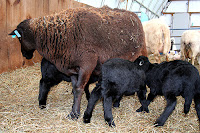 Upon purchasing his Beinn Bhreagh estate near the town of Baddeck, Nova Scotia, Alexander Graham Bell (inventor of the telephone) found himself to be in possession of a sheep flock.
Upon purchasing his Beinn Bhreagh estate near the town of Baddeck, Nova Scotia, Alexander Graham Bell (inventor of the telephone) found himself to be in possession of a sheep flock.In the spring of 1890, half of the lambs born on his estate turned out to be twins. Thinking that the percentage of twins was higher than normal, Bell set out to examine the mothers of the twins and compare them to the mothers who had singles. He found a difference.
While normal sheep have only two nipples, Bell found that several of his sheep had supplementary nipples. The extra nipples were not functional, but Bell found that the sheep with extra nipples were more likely to have twins: 43% vs. 24% for the normally-nippled sheep.
Bell decided to run some experiments to see if the extra nipples could be made functional and whether ewes possessing four nipples instead of two were more fertile.
As to the first goal, Bell's breeding program eventually yielded five and six-nippled, even eight-nippled sheep and at least four of the nipples were functional. His second hypothesis -- that multi-nippled sheep were more fertile -- was disproven, though Bell attributed this to his small sample size. Bell had hoped to impart genes from his twin-bearing sheep to sheep in other flocks.
Read article in Retrospectable: A Neuroscience Blog
Thanks to Bev Pearsall for suggesting this article for the blog.
